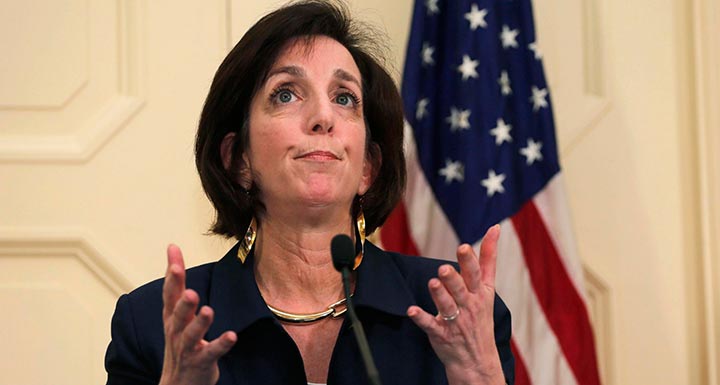
Cuba: The weight of a long history
WASHINGTON, DC – The U.S. and Cuba are meeting again this week for their second round of normalization talks. When asked by the media what she expected from the first round, Roberta Jacobson, the senior diplomat leading the U.S. team, said that she was “not oblivious to the weight of history.” She was right on target: There is a very long history that begins well before the Revolution, deserves careful analysis, and will impact the talks.
As far back as 1809, Jefferson tried to purchase Cuba. In 1820 he went further; he told Secretary of War J.C. Calhoun that the U.S. “ought, at the first possible opportunity, to take Cuba.” As President, John Quincy Adams predicted that Cuba would fall “like a ripening plum into the lap of the union.” These are but two of many prominent examples of a widespread ambition to annex Cuba, or at least to control its destiny, from very early in U.S. history. After “the West,” Cuba figured as a prominent second place in U.S. expansionist aims from the beginning of the Republic.
In subsequent decades, support for annexing Cuba shifted tactically to Southerners who saw Cuba as a potential new slave state, though “manifest destiny” continued to be the fundamental driving force. Presidents Polk, in 1848, and Pierce, in 1854, offered unsuccessfully to buy Cuba. John Louis O’Sullivan, the newspaper editor who coined the phrase “Manifest Destiny” in 1845, supported Cuba’s best-known “annexationist,” taking him to Polk’s White House in search of support for his armed expeditions. And even Walt Whitman—no advocate of slavery—wrote in 1871 that, “‘manifest destiny’ certainly points to the speedy annexation of Cuba by the United States.”
President McKinley again unsuccessfully offered to buy Cuba in 1898, shortly before declaring war on Spain. Only a year before, his Undersecretary of War, I.C. Breckenridge, had reflected the annexationist thinking in a memo arguing that: “We must impose a harsh blockade so that hunger and its constant companion, disease, undermine the peaceful population and decimate the Cuban Army….in order to annex the Pearl of the Antilles [Cuba].” He meant the Cuban independence army, who had all but defeated the Spanish well before Roosevelt with his Rough Riders arrived to clean up. It was advocacy of a policy to starve the Cuban population and its army, just to make sure that the U.S. alone could determine the future of the island. The push for annexation eventually failed, in no small part because its supporters realized that Cubans would likely continue their war if the U.S. tried to impose it. Yet those who favored annexation were able to impose the Platt Amendment on the new Cuban Constitution in 1904, in effect granting the US the right to intervene in Cuba for practically any reason the US saw fit. Cuba’s independence was brutally truncated, and the U.S. intervened on the island again in 1906, 1912, 1917 and 1920.
During the 1930s and 40s, the ambition to control Cuba’s destiny continued—if somewhat more subtly and without troops. The U.S. sent Sumner Welles as a special envoy to Cuba in the 1930’s to ensure that the outcome of a populist insurrection against Gerardo Machado, then Cuba’s dictator, did not steer the island away from U.S. tutelage. This intervention gave rise to the U.S. support for Fulgencio Batista, which lasted until his overthrow in 1959 by the Revolution. As our ambassador to Cuba at the time, Earl T. Smith, asserted during a Senate hearing in 1960: “Until Castro, the U.S. was so overwhelmingly influential in Cuba that the American ambassador was the second most important man, sometimes even more important than the Cuban president.”
The ambition to control Cuba, in other words, already had a long and complex history by the time of the victory of the Revolution in 1959. The list of U.S. interventions seeking regime change that followed is too long to detail here. The Bay of Pigs, assassination efforts, hundreds of acts of sabotage and terrorism, and, of course, the embargo since 1960. And what did the embargo seek? Well, President Eisenhower said that “if the [Cuban people] are hungry they will throw Castro out,” a view that President Kennedy reiterated when he asserted that the end of the Revolution would come from “rising discomfort among hungry Cubans.” Arguably, a policy with the same goal of maintaining Cuba as a client state as the Breckenridge memo of half a century before. The embargo was then codified in the so-called Torricelli and Helms-Burton laws of 1992 and 1996, both supposedly granting the U.S. the right to decide what kind of government the island could have, and laws that were passed well after the Soviet Union had collapsed, the Cold War ended, and Cuba had stopped its revolutionary activities in both Africa and Latin America. In effect, these laws are modern versions of the Platt Amendment, no longer “justified” even by the Cold War fig leaf.
So the history of U.S. policy towards Cuba shows a continuity that is hard to deny. Even those who might disagree with this interpretation should not find it hard to imagine how the Cuban government, and Cubans as a whole, would react with profound skepticism and distrust of the intentions of the most powerful country in the world, as reflected by these kinds of pressures and policies for more than two centuries. Beyond the immediate issues, such as the irrational listing of Cuba in the list of countries that sponsor terrorism, Ms. Jacobson will certainly have a very heavy weight of history to consider in her discussions with her Cuban counterparts. If the President directs her, however, she, on behalf of our country, will have a unique opportunity to break clear from the interventionist thrust of our past interventionist policies, and seek agreements that nurture common interests and respect the obvious differences between the U.S. and the island.
Manuel R. Gomez is a Cuban-American public health professional who resides in Washington, DC.

